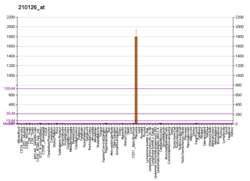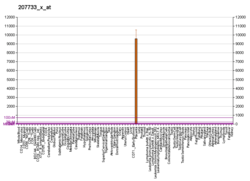Pregnancy-specific beta-1-glycoprotein 9 is a protein that in humans is encoded by the PSG9 gene.[3][4]
Further reading
- Brophy BK, MacDonald RE, McLenachan PA, Mansfield BC (1992). "cDNA sequence of the pregnancy-specific beta 1-glycoprotein-11s (PSG-11s)". Biochim. Biophys. Acta. 1131 (1): 119–21. doi:10.1016/0167-4781(92)90110-l. PMID 1581354.
- Thompson J, Koumari R, Wagner K, et al. (1990). "The human pregnancy-specific glycoprotein genes are tightly linked on the long arm of chromosome 19 and are coordinately expressed". Biochem. Biophys. Res. Commun. 167 (2): 848–59. doi:10.1016/0006-291X(90)92103-7. PMID 1690992.
- Chan WY, Zheng QX, McMahon J, Tease LA (1991). "Characterization of new members of the pregnancy-specific beta 1-glycoprotein family". Mol. Cell. Biochem. 106 (2): 161–70. doi:10.1007/BF00230182. PMID 1922019.
- Arakawa F, Kuroki M, Misumi Y, et al. (1990). "The nucleotide and deduced amino acid sequences of a cDNA encoding a new species of pregnancy-specific beta 1-glycoprotein (PS beta G)". Biochim. Biophys. Acta. 1048 (2–3): 303–5. doi:10.1016/0167-4781(90)90072-a. PMID 2322584.
- Khan WN, Hammarström S (1990). "Identification of a new carcinoembryonic antigen (CEA) family member in human fetal liver--cloning and sequence determination of pregnancy-specific glycoprotein 7". Biochem. Biophys. Res. Commun. 168 (1): 214–25. doi:10.1016/0006-291X(90)91696-P. PMID 2328001.
- Streydio C, Swillens S, Georges M, et al. (1990). "Structure, evolution and chromosomal localization of the human pregnancy-specific beta 1 glycoprotein gene family". Genomics. 6 (4): 579–92. doi:10.1016/0888-7543(90)90492-D. PMID 2341148.
- Zheng QX, Tease LA, Shupert WL, Chan WY (1990). "Characterization of cDNAs of the human pregnancy-specific beta 1-glycoprotein family, a new subfamily of the immunoglobulin gene superfamily". Biochemistry. 29 (11): 2845–52. doi:10.1021/bi00463a030. PMID 2346748.
- Barnett TR, Kretschmer A, Austen DA, et al. (1989). "Carcinoembryonic antigens: alternative splicing accounts for the multiple mRNAs that code for novel members of the carcinoembryonic antigen family". J. Cell Biol. 108 (2): 267–76. doi:10.1083/jcb.108.2.267. PMC 2115422. PMID 2537311.
- Teglund S, Zhou GQ, Hammarström S (1995). "Characterization of cDNA encoding novel pregnancy-specific glycoprotein variants". Biochem. Biophys. Res. Commun. 211 (2): 656–64. doi:10.1006/bbrc.1995.1862. PMID 7794280.
- Olsen A, Teglund S, Nelson D, et al. (1995). "Gene organization of the pregnancy-specific glycoprotein region on human chromosome 19: assembly and analysis of a 700-kb cosmid contig spanning the region". Genomics. 23 (3): 659–68. doi:10.1006/geno.1994.1555. PMID 7851895.
- Strausberg RL, Feingold EA, Grouse LH, et al. (2003). "Generation and initial analysis of more than 15,000 full-length human and mouse cDNA sequences". Proc. Natl. Acad. Sci. U.S.A. 99 (26): 16899–903. doi:10.1073/pnas.242603899. PMC 139241. PMID 12477932.
- Grimwood J, Gordon LA, Olsen A, et al. (2004). "The DNA sequence and biology of human chromosome 19". Nature. 428 (6982): 529–35. doi:10.1038/nature02399. PMID 15057824.
- Colland F, Jacq X, Trouplin V, et al. (2004). "Functional proteomics mapping of a human signaling pathway". Genome Res. 14 (7): 1324–32. doi:10.1101/gr.2334104. PMC 442148. PMID 15231748.
- Gerhard DS, Wagner L, Feingold EA, et al. (2004). "The status, quality, and expansion of the NIH full-length cDNA project: the Mammalian Gene Collection (MGC)". Genome Res. 14 (10B): 2121–7. doi:10.1101/gr.2596504. PMC 528928. PMID 15489334.
- Salahshor S, Goncalves J, Chetty R, et al. (2006). "Differential gene expression profile reveals deregulation of pregnancy specific beta1 glycoprotein 9 early during colorectal carcinogenesis". BMC Cancer. 5: 66. doi:10.1186/1471-2407-5-66. PMC 1184062. PMID 15982419.
- Stelzl U, Worm U, Lalowski M, et al. (2005). "A human protein-protein interaction network: a resource for annotating the proteome". Cell. 122 (6): 957–68. doi:10.1016/j.cell.2005.08.029. PMID 16169070.



